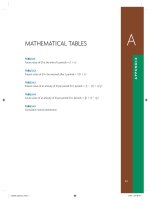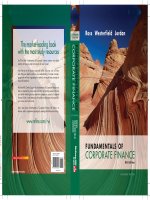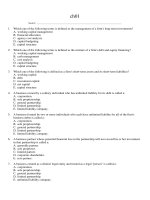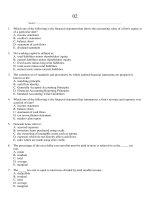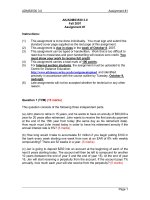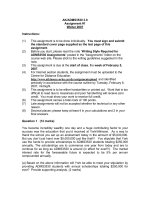assignment3 fundamentals of corporate finance, 4th edition brealey
Bạn đang xem bản rút gọn của tài liệu. Xem và tải ngay bản đầy đủ của tài liệu tại đây (202.67 KB, 15 trang )
AK/ADMS3530 3.0
Assignment #1 Solutions
Winter 2007
Question 1 (12 marks)
You became incredibly wealthy one day and a huge contributing factor to your
success was the education that you’d received at York/Atkinson. As a way to
thank the school you set up an endowment today in the amount of $5,000,000.
But you don’t just hand over $5,000,000 just like that!!! You stipulate that York
use the funds to provide scholarships to ADMS3530 students totaling $250,000
annually. The scholarships are to commence one year from today and are to
continue for as long as ADMS3530 is around (in effect for ever!!!). The market
interest rate for the foreseeable future is expected to be 5% per annum
compounded annually.
(a) Based on the above information will York be able to meet your stipulation by
providing ADMS3530 students with annual scholarships totaling $250,000 for
ever? Provide supporting analysis. (2 marks)
Answer
This is a perpetuity question. The formula should be of the form
PV perpetuity = Annual Payment / Annual Int. Rate
OR
Endowment = Annual Scholarship / Annual Int. Rate
Endowment = $250,000 / 5% = $250,000 / 0.05 = $5,000,000
Therefore your $5,000,000 endowment is sufficient to fund annual scholarships
of $250,000 forever based on a prevailing annual interest rate of 5%.
(b) What if your endowment was $4,000,000 instead of $5,000,000 would York
still be able to meet your stipulation? If not what would be the maximum annual
scholarship payout? Provide supporting analysis. (3 marks)
Answer
Based on the answer above York would NOT be able to meet you stipulation as
there would be a shortfall in the endowment of $5,000,000 - $4,000,000 =
$1,000,000.
With a $4,000,000 endowment the Annual Scholarship = Endowment * Annual
Int. Rate
ADMS3530 3.0
Assignment #1 Solutions
Annual Scholarship = $4,000,000 * 0.05 = $200,000
Therefore with a $4,000,000 endowment York would be able to fund a maximum
annual scholarship of $200,000 with prevailing annual interest rates of 5%.
(c) As we all know the cost of education keeps going up and up. To
accommodate these inflationary pressures you ask that the $250,000 scholarship
grow at a constant rate of 1% annually. Would York be able to fund this
scholarship for ever with your $5,000,000 endowment? If not what would be the
maximum annual scholarship? Provide supporting analysis. (4 marks)
Answer
PV perpetuity = Annual Payment / (Annual Int. Rate – Growth Rate of Payment)
OR
Endowment = Annual Scholarship / (Annual Int. Rate – Growth Rate of
Scholarship)
Endowment = $250,000 / (0.05 – 0.01) = $6,250,000
Therefore with an endowment of $5,000,000 there would be shortfall of
$6,250,000 – $5,000,000 = $1,250,000.
Annual Scholarship = Endowment * (Annual Int. Rate – Constant Growth Rate of
Scholarship)
Annual Scholarship = $5,000,000 * (0.05 – 0.01) = $200,000
With an endowment of $5,000,000 York would be able to fund an annual
scholarship of $200,000 that would grow at a constant annual rate of 1%.
(d) What would your endowment have to be to accommodate annual
scholarships of $300,000 with a constant growth rate of 1% annually? Provide
supporting analysis. (3 marks)
Answer
Endowment = Annual Scholarship / (Annual Int. Rate – Growth Rate of
Scholarship)
Endowment = $300,000 / (0.05 – 0.01) = $7,500,000
Therefore an endowment of $5,000,000 would be required to fund an annual
scholarship of $300,000 that would grow at a constant annual rate of 1%.
Page 2
ADMS3530 3.0
Assignment #1 Solutions
Question 2 (9 marks)
You have finally decided that this is the year that you purchase that exotic car
(Aston Martin Vanquish (007’s car), Porsche Carrerra GT, Bentley Continental
etc…etc.). But your spouse (Salma Hayak or Brad Pitt depending on who you
are) insists that you must decide on the maximum purchase price you can afford
before you ever look at your first car.
Assume that the only source of money to finance your purchase is based on your
family income. The details of which follow…
Your annual income is $50,000 before taxes which is taxed at a flat rate of 30%.
Of the after tax income you can commit 25% annually towards the purchase of
the car for the next 5 years (starting 1 year from today).
Your spouse’s annual income is $5,000,000!!! (remember it’s Salma or Brad)
before taxes which is taxed at a flat rate of 50%. Of the after tax income your
spouse will only commit 0.5% annually to the purchase of your car for the next 3
years (starting 1 year from today).
The prevailing rate of interest on auto loans in the market place is 7%
compounded annually.
Assuming you can get an auto loan, can you afford one of the luxury cars which
are priced today at over $250,000? Or will you have to buy a Honda Odyssey
(which costs approx $50,000) mini van which is that much more practical as you
have 3 small children. Show your calculations to support your decision.
Answer
There are a number of ways to solve this question. I’ve included solutions for
two different approaches.
The question requires that you calculate the PV of cash that is available to you to
finance the purchase of your car. If the PV is equal to or greater than $250,000
then you can afford the exotic car. If it’s greater than $50,000 but less than
$250,000 then you can afford the Honda Odyssey.
Available money = available from my income + available from spouse’s income
Money available from my income = $50,000 * (1 - 0.30) * 0.25 = $8,750 annually
for 5 yrs starting one year from today.
Money available from spouse’s income = $5,000,000 * (1 - 0.50) * 0.005 =
$12,500 annually for 3 yrs starting one year from today.
Solved using the PV formula PV = FV / (1+r)^t
From my income, PV of money available for years 1 to 5
= [8,750 / (1 + 0.07)^1] + [8,750 / (1 + 0.07)^2 ]+[ 8,750 / (1 + 0.07)^3 ]+
Page 3
ADMS3530 3.0
Assignment #1 Solutions
[8,750 / (1 + 0.07)^4] + [8,750 / (1 + 0.07)^5]
=$35,876.73.
From spouse’s income, PV of money available for years 1 to 3
= [12,500 / (1 + 0.07)^1] + [12,500 / (1 + 0.07)^2] + [12,500 / (1 + 0.07)^3]
= $32,803.95
Total PV available = $35,876.73 + $32,803.95 = $68,680.68.
Therefore we cannot afford a $250,000 exotic vehicle however we can afford the
$50,000 Honda Odyssey.
Solved using the annuity formula
PV of your income
PV of your spouse’s income
Total PV of income
available
= C x [1/r - 1 / r(1+r)^t] =
= C x [1/r - 1 / r(1+r)^t] =
$68,680.68
8750*((1/0.07)-1/(0.07*(1.07^5))) =
12,500*((1/0.07)-1/(0.07*(1.07^3))) =
Question 3 (15 marks)
RRSP season is coming up and Canadians will be faced with many
investment opportunities. Assume that you are a Canadian resident with a
marginal tax rate of 40%. You have decided to invest in a $1,000 RRSP.
Since this is tax deductible and you will receive a $400 tax refund given your
marginal tax rate (40% of $1,000). You have two options available to you.
The first is presented here and the second appears in part (c) below. In order
to buy the RRSP you may borrow $1,000 and then pay down your $1,000
loan with the $400 immediate tax refund. Throughout this question interest
rate is assumed to be 9% compounded monthly.
(a)
What is the monthly payment required to pay down the loan in one year?
(2 marks)
Answer
Since $400 will be paid down immediately we need to calculate the PMT
on a $600 loan balance.
PMT =? n = 12, i = 9% compounded monthly (i.e. monthly interest rate is
0.75%), PV=$600, then:
Page 4
$35,876.73
$32,803.95
ADMS3530 3.0
Assignment #1 Solutions
1
1
PV of an annuity = C × −
t
r r (1 + r )
1
1
PV of an annuity = C ×
=$600
−
12
.0075 .0075(1 + .0075)
∴ C = $600/11.4349 = $52.47.
(b)
To what will the single $1,000 contribution grow over the next 20 years? (2
marks)
Answer
PV = $1,000, n = 20, i = 9% compounded monthly, then:
FV = PV × (1 + r )
t
FV = PV × (1 + .0075)
FV = $6,009.15
(c)
240
Let’s say that you opted rather than borrow the $1,000 and immediately
pay down the $400 and then pay out the loan over a one year period (as
in part (a) above) that you agreed last year to make monthly contributions
to a savings plan in order to realize a $600 payout by the end of the 12th
month (i.e. today) and then borrow the remaining $400 to purchase the
$1,000 RRSP now, how much would you need to save on a monthly
basis? You will immediately pay down the $400 by the end of the first
month that it is due. (3 marks)
Answer
FV = $600, n = 12, i = 9% compounded monthly, then:
(1 + r ) t − 1
FV of an annuity = C ×
r
(1 + .0075)12 − 1
$600 = C ×
.0075
C = $600/12.5076 = $47.97
(d)
Assuming that you would like to continue your RRSP investment in part
(a) or part (c) annually for the next 20 years until your retirement.
Page 5
ADMS3530 3.0
Assignment #1 Solutions
Compare the two RRSP plans by calculating the PV of both options. (4
marks)
Answer
The actual present value of both will be the same. The difference will lie in
the net expense of carrying the annuity each year for 20 years.
PMT = $1,000, n = 20, i = 9% compounded monthly, then:
the monthly interest rate (rmon) = i/12 = 0.75%,
and the EAR = (1 + rmon ) m − 1 = (1 + 0.75%)12 − 1 = 9.38069%.
1
1
PV of annuity = PMT × [
−
]
EAR EAR (1 + EAR ) n
1
1
= $1,000 × [
−
]
0.0938069 0.0938069(1.0938069 20 )
= $1,000 × 8.8862 = $8,886.20.
(e)
What is the benefit of one plan over the other assuming that the interest
rate remains at 9% monthly compounded throughout the next 20 years? (4
marks)
Answer
The difference will lie in the actual cash flow savings and payments
generated by the savings plan versus the interest which needs to be paid
on the loans (ignoring the tax expense deduction for now).
From (a) we can calculate that the annual interest payments as equal to
($52.47)(12) - $600 = $29.64. This should be a negative cash flow per
year from the perspective of the RRSP investor.
From (c) we can calculate the positive cash flow of $24.36 (= $600 –
$575.64) each year. This is beneficial to the RRSP investor. So the
savings plan in (c) is preferred to the borrowing plan in (a).
Question 4 (13 marks)
Another Canadian investor is planning his retirement.
information please help him with his calculations.
(a)
Given the following
What will be the amount in an RRSP after 25 years, at which time he will
retire and live off the proceeds, if contributions of $3,000 are made at each
year-end for its first seven years and month-end contributions of $500 are
Page 6
ADMS3530 3.0
Assignment #1 Solutions
made for the subsequent 18 years? Assume that the plan earns 8%
compounded quarterly for the first 12 years, and 7% compounded
semiannually for the subsequent 13 years. (4 marks)
Answer
For the first 7 years, i =
n = 1(7) = 7, c =
4
1
8%
4
= 2%, PMT = $3,000,
= 4, and
EAR = (1 + i ) − 1 = (1.02)4 – 1 = 0.082432160
c
Amount in the RRSP after 7 years will be
1.08243216 7 − 1
= $26,968.51
0.08243216
FV = $3,000
For the next 5 years, PMT = $500,
n = 12(5) = 60, and
1 / 12
c
rmon = (1 + EAR ) − 1 = (1.08243216) – 1 = 0.00662271
Amount in the RRSP after 12 years will be
(1 + i )n − 1
i
FV = PV (1 + i )n + PMT
1.00662271 60 − 1
= $26,968.51 (1.02 )20 + $500
0.00662271
= $76,761.75
For the last 13 years, PMT = $500, n = 12(13) = 156,
i = 72% = 3.5%, and
EAR = (1.035) 2 − 1 = 0.071225
rmon = (1 + EAR ) − 1 = (1.071225)
1 / 12
c
– 1 = 0.00575
Amount in the RRSP after 25 years will be
(1 + i )n − 1
i
FV = PV (1 + i )n + PMT
1.00575156 − 1
= $76,761.75 (1.035 )26 + $500
0.00575
= $313,490.28
(b)
Your investor would like to set up a Scholarship Fund in his name at
Atkinson College with a $500 annual award to a deserving applicant. The
first award will be made at the end of the 15th year of his retirement.
Subsequent awards will be made at the end of each year perpetually.
Page 7
ADMS3530 3.0
Assignment #1 Solutions
Given the RRSP amount in part (a) above, how much can your investor
expect to withdraw at the end of each month, starting the first month after
his retirement, and still be able to set up the Scholarship Fund?
(Assume the interest rate is 10% compounded monthly throughout his
retirement.) (6 marks)
Answer
i. First we need to calculate how much will be required to set aside at Year
15 for the scholarship:
i = 1012% = .83333%, C = $500,
c = 121 = 12, and
i2 = (1 + i )c − 1 = (1.0083333) – 1 = 0.104709
12
PV of a perpetuity =
=
C
r
$500
0.104709
= $4,775.14
ii. Then we need to calculate the PV of this amount and deduct it from the
fund at the start of the retirement $313,490.28
PV of $4,775.14 for 15 years at 10% compounded monthly is $1,072.18
Subtract this from the fund:
$313,490.28 - $1,072.18 = $312,418.10
(Alternately by using the calculator you could find the answer by allowing
for a residual FV at the beginning of Year 15 of $4,775.14.)
iii. Calculate the monthly payments on the PV of $312,418.10 at 10%
compounded monthly:
1
1
PV of an annuity = C × −
t
r r (1 + r )
1
1
−
180
.008333 .008333(1 + .008333)
$312,418.10 = C ×
C = $3,357.96
Page 8
ADMS3530 3.0
(c)
Assignment #1 Solutions
What complications might occur in achieving the plan in part (b)? (3
marks)
Answer
The main purpose of the question is to have you discuss the fact that
upon retirement no one can really plan when they will die.
There are two concerns to be addressed:
1.
What will happen if the investor dies before the beginning of the
15th year? A simple solution would include a will that ensures
that the annuity is taken over by a 3rd party, either as an
inheritance or as an asset in the estate.
2.
The real issue is what if the investor survives beyond the 15th
year; there is no more money except for the small amount that
has been set aside as a scholarship. The investor either
becomes a ward of the family or the state.
Question 5 (14 marks)
Throughout this question consider the following bond: face value of $1,000,
coupon rate is 8%, semi-annual coupon payments, 4 years of maturity, and a
purchase price of $1,055.69.
(a)
Calculate the current yield and yield to maturity on the bond as of the date
of purchase. (3 marks)
Answer
$80
annual coupon 0.08 × $1,000
=
=
= 7.58%.
bond price
$1,055.69
$1,055.69
If you use your financial calculator, you will find the yield to maturity (YTM)
to be 6.4%. Alternatively, if you use the approximate formula, the YTM is:
Current yield =
Page 9
ADMS3530 3.0
Assignment #1 Solutions
(face value − current price)
maturity
YTM =
(face value + current price)
2
($1,000 − $1,055.69)
$80 +
4
=
= 6.4287%.
($1,000 + $1,055.69)
2
annual coupon +
(b)
Calculate the current yield and bond price on each anniversary date of the
bond purchase until maturity. Suppose on each of these dates the yield to
maturity on the bond is 7%, 6.6%, 6.2%, and 6.36%, respectively. (6
marks)
Answer
To illustrate, let’s compute the current yield and bond price on the first
anniversary. The calculations for the other anniversaries follow suit.
face value
1
1
Bond price = coupon × [ −
]+
t
r r (1 + r )
(1 + r ) t
$1,000
1
1
−
]+
= $1,026.64.
6
0.035 0.035(1 + 0.035)
1.035 6
annual coupon 0.08 × $1,000
$80
Current yield =
=
=
= 7.79%.
bond price
$1,026.64
$1,026.64
= $40 × [
For the second and third anniversaries and the maturity date, the bond
price and current yield (in parentheses) is: $1,025.83 (7.8%), $1,017.2
(7.86%), and $1,000 (8%).
(c)
Assume instead of holding the bond until maturity, you sell the bond on
the second anniversary of its purchase (right after you receive the last
coupon). Based on your results in part (b) above, what is your total rate of
return over this 2-year holding period? What is your annual rate of return
over the same period? Assume you can reinvest the previous coupons at
an APR of 10% quarterly compounded. (5 marks)
Answer
First, we need to compute the semi-annual interest rate on reinvestment.
Semi − annual rate = (1 + quarterly rate) 2 − 1
APR 2
= (1 +
) − 1 = 5.0625%.
4
Page 10
ADMS3530 3.0
Assignment #1 Solutions
Since the income from coupons can be regarded as a 4-period annuity,
we apply the future value formula for an annuity:
(1 + r ) t − 1
Income = FV of an annuity = coupon × [
]
r
(1 + 0.050625) 4 − 1
= $40 × [
] = $172.57.
0.050625
The total rate of return over the two-year holding period is:
coupon income + capital loss
Rate of return =
initial price
$172.57 + ($1,025.83 − $1,055.69)
=
= 13.5182%.
$1,055.69
The annual rate of return is calculated as:
(1 + total rate of return )1 / m − 1 = (1 + 0.135182)1 / 2 − 1 = 6.54%.
Question 6 (8 marks)
This question has two parts, (a) and (b).
(a)
Do you think it is necessary for bond prices to fluctuate in response to
changing interest rates? Why? Please limit your answer to one paragraph.
(4 marks)
Answer
Yes. Bonds are long-term debt instruments that are issued with fixed
coupon rates. At time of issue, it is likely that the coupon rate was
approximately equal to the expected interest rate for a bond of this rating.
However, as interest rates change during the period before maturity,
investors may be unwilling to purchase the bond in the secondary market
unless its price changes such that the investor can obtain a then-current
yield to maturity on the investment. Thus, if bond prices were fixed, there
may not be any opportunities for sale of the bond prior to maturity and
investors would be required to make long-term, potentially
disadvantageous investment decisions.
(b)
Why should investors be cautious when replying on yield to maturity as
a measure of the return on their bond investment? Please limit your
answer to one paragraph. (4 marks)
Answer
Many bond investors do not intend or, even if they do intend, will not be
Page 11
ADMS3530 3.0
Assignment #1 Solutions
able to, to hold their bonds until maturity. In this case it is worthwhile to
remember that a yield to maturity is promised only if: 1) the bond is held
until maturity, and 2) the issuer does not default. Many investors might be
better off in calculating or forecasting a total return based upon the time
period they expect to hold the bond. While this calculation is obviously
made with risk, it reminds investors that bond prices can change
dramatically and, if you need to raise cash quickly, the once-calculated
yield to maturity can be no longer valid.
Question 7 (15 marks)
Rite Bite Enterprises historically has not been a dividend paying company but in
its latest board meeting the company decided to start paying a fixed dividend of
$1.5 for the next year. After the first dividend, they expect that the dividend will
grow at 5% over the following three years and it will maintain a constant 6%
annual growth rate thereafter. (Please draw a timeline to show your work.)
a. What are the expected dividends in years 5 and 10? (2 marks)
b. If the discount rate for the stock is 10%, at what price will the stock sell today?
(5 marks)
c. What is the expected stock price three years from now? (3 marks)
d. If your annual required rate of return is 12% for the next 4 years and 8%
thereafter how much will you pay for a share of Rite Bite’s stocks today? (5
marks)
Answer:
0
1
2
3
4
5
6
7…….
I--------I--------I--------I--------I--------I--------I--------I--------I
D0
D1
D2
D3
D4
g=5%
D5
D6
g=6%
P4
a.
D0 = $0, D1 = $1.5
D2 = $1.5*1.05 = $1.575
D3 = $1.575*1.05 = $1.6538
D4 = $1.6538*1.05 = $1.7365
D5 = $1.7365*1.06 = $1.8407
D10=$1.8407*(1.06)^5 = $2.4633
Page 12
ADMS3530 3.0
Assignment #1 Solutions
b. P4 = $1.8407/(0.10-0.06) = $46.02
PV of Dividends and P4
PV of D1= $1.5*(PVIF10%,1)
= $1.3636
PV of D2 = $1.575*(PVIF10%,2) = $1.3017
PV of D3 = $1.6538*(PVIF10%,3) = $1.2425
PV of D4 = $1.7365*(PVIF10%,4) = $1.1861
PV of P4 = $46.02*(PVIF10%,4) = $31.4323
or
or
or
or
or
$1.5/1.10
$1.575/1.102
$1.6538/1.103
$1.7365/(1.10)4
$46.02/(1.10)4
P0 = $1.3636+$1.3017+$1.2425+$1.1861+$31.4323 = $36.53
c. P3 =$1.7365*(PVIF10%,1) + $46.02*(PVIF10%,1) = $1.5786+$41.8364=$43.42
d.
0
1
2
3
4
5
6
7…….
I--------I--------I--------I--------I--------I--------I--------I--------I
D0
D1
D2
D3
D4
g=5%
r=12%
D5
D6
g=6%
r=8%
P4
D1 = $1.5
D0 = $0,
D2 = $1.5*1.05 = $1.575
D3 = $1.575*1.05 = $1.6538
D4 = $1.6538*1.05 = $1.7365
D5 = $1.7365*1.06 = $1.8407
P4 = $1.8407/(0.08-0.06) = $92.04
PV of Dividends and P4
PV of D1= $1.5*(PVIF12%,1)
= $1.3393
PV of D2 = $1.575*(PVIF12%,2) = $1.2556
PV of D3 = $1.6538*(PVIF12%,3) = $1.1771
PV of D4 = $1.7365*(PVIF12%,4) = $1.1036
PV of P4 = $92.04*(PVIF12%,4) = $58.4931
or
or
or
or
or
$1.5/1.12
$1.575/1.122
$1.6538/1.123
$1.7365/(1.12)4
$92.04/(1.12)4
P0 = $1.3393+$1.2556+$1.1771+$1.1036+$58.4931 = $63.37
Question 8 (14 marks)
This question has two parts, (a) and (b).
(a) The common stock of Veritas Ltd. is currently trading at $ 48 on the TSX. You
also know the following information about the Veritas stock: its P/E ratio is 16,
Page 13
ADMS3530 3.0
Assignment #1 Solutions
Veritas Ltd. has a required rate of return of 10% on its common equity, and the
company’s dividends are expected to grow at 6% forever. What is Veritas’ payout
ratio today? What is Veritas’ plowback ratio today? (6 marks)
Answer
By use of the constant growth dividend discount model, we can compute the
dividend paid by VERITAS Ltd. today, D0, as:
D (1 + g )
D (1 + 6%) D0 (1.06)
P0 = 0
⇒ $48 = 0
=
r−g
10% − 6%
0.04
$48 × 0.04
∴ D0 =
= $1.811
1.06
We know that this company has an earning per share (EPS) of $48/16 = $3.
Using the definition of payout ratio, we can compute VERITAS’ payout ratio today
as $1.811/$3 = 60.37%. Finally, VERITAS’ plowback ratio today is (1 – payout
ratio) = 39.63%.
(b) Butterfly Tractors Corp. has experienced an outstanding growth in recent
years, which is expected to continue in the future. In particular, earnings and
dividends are forecasted to grow at a rate of 5% during the next 3 years, and at a
constant rate of 6% thereafter. Butterfly just paid a dividend of $2 and the
required rate of return on its stock is 12%. Suppose that you buy one share of
Butterfly stock today and sell it at the end of Year 4. Compute the 1-year dividend
yield, 1-year capital gains yield, and 1-year total rate of return on your investment
for each of Years 1, 2, 3, and 4. Assume that previous dividends are not
reinvested. (8 Marks)
Answer:
We first calculate the stock price today, P0:
D0 = $2
D1 = $2*1.05=$2.1
D2 = $2.1*1.05 = $2.205
D3 = $2.205*1.05 = $2.3153
D4 = $2.3153*1.06 = $2.4542
P0 =
$2.1 $2.205 $2.3153
$2.4542
+
+
+[
] /(1.12) 3
2
3
−
1.12 1.12
12
%
6
%
1.12
= 1.875 + 1.7578 + 1.648 + (40.9033 / 1.4049) = $34.396
Likewise, we can compute Butterfly’s stock price at the end of Year 1, 2, 3, and 4
as:
Page 14
ADMS3530 3.0
Assignment #1 Solutions
P1 =
$2.205 $2.3153 + 40.9033
+
= $36.4224
1.12
(1.12) 2
P2 =
$2.3153 + $40.9033
= $38.588
1.12
P3 =
$2.4542
12% − 6%
P4 =
$2.4542 × (1 + 6%)
=$43.3583
12% − 6%
= $40.9033
Therefore, we have the following 1-year returns:
Year
1
2
3
4
Dividend Yield
2.1/34.396=6.11%
2.205/36.4224=6.05%
2.3153/38.588=6%
2.4542/40.9033=6%
Capital Gains Yield
(36.4224-34.396)/34.396=5.89%
(38.5880-36.4224)/ 36.4224=5.95%
(40.9033-38.5880)/ 38.5880=6%
(43.3583-40.9033)/ 40.9033=6%
Total Rate
of Return
12%
12%
12%
12%
Page 15
